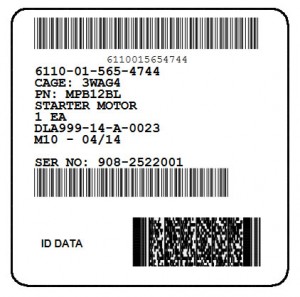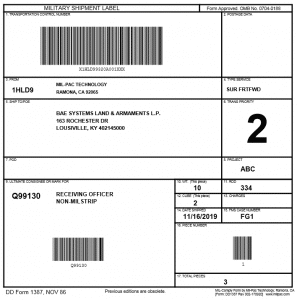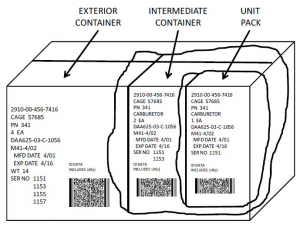Mil-Std-129R Guidance
Mil-Std-129 prescribes how DOD suppliers are to mark shipments to the military. Like many technical specifications it can be difficult to comprehend, particularly for those new to defense contracting. This guide is intended to simplify compliance with the latest revision of the Mil-Std-129 (Revision R, Change Notice 2) and provide some clarification of its complex rules. See examples of Mil-Std-129R labels.
The first thing to know is that there are three kinds of containers: unit, intermediate and exterior, as shown below. There are rules for marking each container level, and for unpacked items. Note that pallets are not containers, rather something that containers sit on. However, there are special marking rules for their use, as well as Radio-Frequency Identification (RFID) tagging implications.
Most shipments use a combination of unit packs and exterior containers. In a broad sense, the unit container may be thought of as the consumer packaging, while the exterior container provides protection for shipping and includes address labeling in the form of the Military Shipment Label(MSL). In cases where the exterior container serves as unit pack, only exterior container marking rules apply.
Migration to PDF417 (2D) Symbols
The use of two-dimensional PDF417 bar codes for container identification was introduced in Mil-Std-129P (Notice 4) as a method of handling the demands of Unique Identification (UID) markings, which at up to fifty characters in length are practically impossible to represent with traditional Code39 linear bar codes.
The PDF417 is a very dense data symbology which can accommodate all of the data 
Have linear bar codes been entirely replaced by the PDF417? Not necessarily. Paragraph 5.4a states that the container identification must include PDF417 symbols and/or linear bar codes. This leaves room for interpretation and some degree of flexibility on the part of the supply chain. It may be advantageous for some data, such as serial numbers, to remain in linear bar code format in addition to the 2D symbol. This would allow automated data collection systems to read the PDF417 while still supporting those in the field with simple linear barcode scanners.
DD Form 1348-1A
Use of the DD Form 1348-1A as a packing list may be required by some contracts, often times for customer direct delivery (See ¶5.11)
In some cases, a DD Form 250 packing list with DD Form 1348 bar codes (see ¶5.12.1) is substituted. The DD1348 and a barcoded DD250 are supported in Comply/Shipper.
5.6.3 Contractor-originated FMS shipments. The DD Form 250 shall be used as a packing list for contractor-originated FMS shipments in lieu of the DD Form 1348-1A, which may be used for FMS shipments originated by DoD activities. The DD Form 250 shall be prepared as specified in the Defense Federal Acquisition Regulation Supplement (DFARS), Appendix F, Part 3, F301, Preparation Instructions.

DD1387 – The original Military Shipment Label
Use of DD1387 Form
Form DD1387 is the predecessor of the Military Shipment Label (MSL) which is in wide use today. The two are very similar, however, the MSL includes a large block for a two-dimensional PDF417 symbol. The 2D symbol encodes all of the data that appears on the MSL, even some that does not, such as the contract, order, shipment and contract line item number of the container contents.
The MSL data encoded in the symbol includes data identifiers that allow it to be interpreted by a machine. Linear barcodes found on the MSL and DD1387 have no such identifiers, though software systems are able to understand it from context. Anyway, besides all of the reasons to use the MSL over the DD1387, Mil-Std-129R is quite clear on the point.
<blockquote “>The use of DD Form 1387, superseded by the MSL, is used under these circumstances: “Attach a DD Form 1387 (Military Shipment Label) in lieu of a bar coded MSL for DoD contingency operations where manual entry is the only means available to document DTS shipments.”[Mil-Std-129R §5.2.1]
Customer Direct Labeling / Direct Vendor Delivery (DVD)
The shipment term “customer direct” replaced “direct vendor delivery (DVD)” in Mil-Std-129R to better align with DoD distribution definitions.
5.5 Customer direct (formerly direct vendor delivery (DVD)). Unless otherwise specified in the contract or solicitation, contractor- or vendor-originated customer direct shipments require identification and address marking with 2D (PDF417) and linear (Code 39) bar codes in accordance with this standard. The issue/receipt bar code marking shall either be placed on or printed on labels affixed to either the DD Form 250/250c or the commercial packing list. If placed on the DD Form 250/250c, they should be in blocks 15, 16, 17, etc. In either case, these documents shall be furnished in a packing list envelope as specified in 5.11.2.a.[Mil-Std-129R §5.5]


